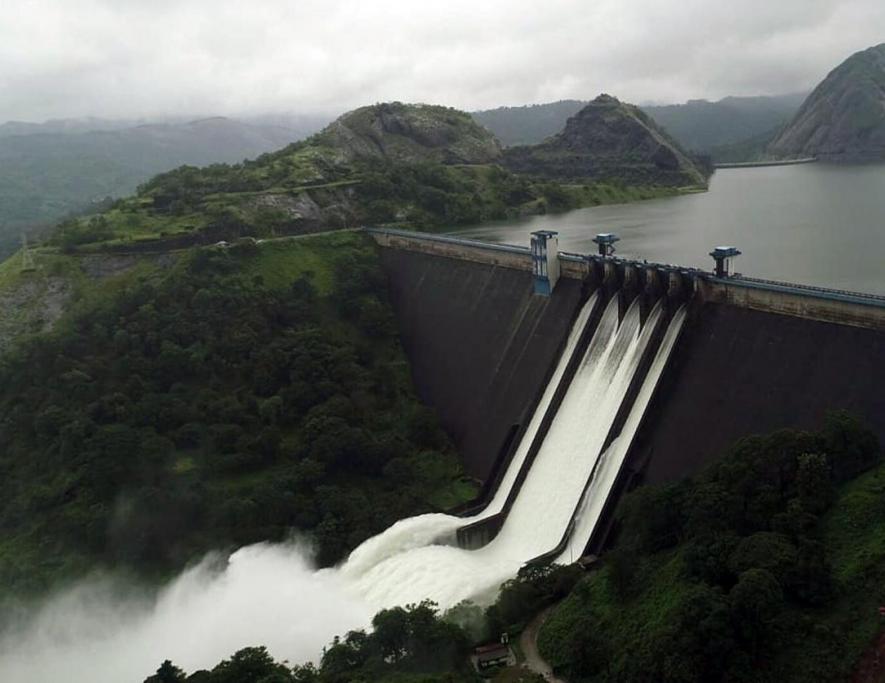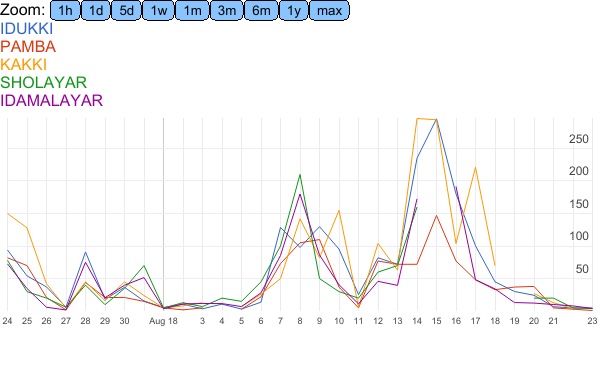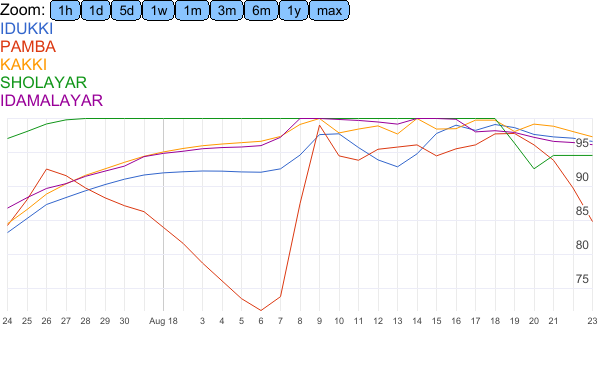Kerala Floods: Lies, Dam Lies & Statistics

When all the 5 shutters of the Cheruthoni/Idukki dam was opened during 2018 Kerala Floods. Image courtesy: Kiranroice/Wiki Commons
The right wing propaganda machinery has been working day and night to tarnish the efforts of the Kerala government and the people to counter the floods in Kerala. The allegations targeting Kerala, ranged from not opening the dam shutters on time, to the relief aid offered to the state by foreign countries. One of such messages was claimed to be written by Dr. Amita Singh, who is a professor at the Centre for the Study of Law and Governance at JNU (Jawaharlal Nehru University). The note said that the reasons behind the devastating floods in Kerala were manmade, and it incriminated the ruling LDF government for causing it. Most of these unsubstantiated allegations were later repeated by the leader of opposition in Kerala, Ramesh Chennithala of the Indian National Congress. The widespread popularity and virality of these messages warrants a fact check of the allegations.
Allegation 1: This flood was not caused merely by excess rain; 40 per cent excess precipitation over three months of monsoons cannot have caused this, nor is it a terrible outlier.
Fact: As per the data released by Indian Meteorological Department, Kerala has experienced a rainfall of 758.6 mm between August 1, 2018 and August 19, 2018. Compared to the normal rainfall of 287.6 mm, this is a change of 164 per cent. This extreme spell of rainfall Kerala received in a very small span of time was the actual cause of Kerala floods. The claim that the rainfall was spread over a long period of three months, propagated by the right wing propaganda machinery, is a devious plan to downplay the magnitude and impact of heavy downpour within a short duration. That takes us to the next allegation. Didn't Kerala government have any idea about the heavy downpour?
READ MORE: Kerala Floods: From Rescue Efforts to Relief and Renewal Work
Allegation 2: Scientifically reliable and freely available weather forecasting systems were predicting 2000 mm of additional precip in Aug.
Fact: While it is true that numerous freely available weather forecasting systems exist, the message does not specify which one predicted the humongous rainfall Kerala was about to receive. Even if someone had actually predicted it, and even if they are actually scientifically reliable, no state government in India can act upon their inputs. The existing rules and procedures related to the disaster management stipulates that the government machineries can act only on the inputs of the IMD (Indian Meteorological Department) under the Central Government. In other words, for the state governments, the only available weather forecasting system is the IMD.
The pertinent question is whether the IMD had predicted the heavy rainfall in Kerala. Let us look into the forecast for South Peninsular India in various IMD releases starting from July 26, 2018. Table 1 lists the excerpts from the IMD releases from 26.07.2018 to 09.08.2018 about Kerala and South Peninsular India.
Table 1: Weather forecasts for south peninsular India by Indian Meteorological Department
| Date of Release | Forecast |
| 26.07.2018 | During Week 2 (02-08 August 2018), above normal rainfall activity is very likely to confine over northern parts of the country and extreme south Peninsular India (including Kerala). |
| 02.08.2018 | During Week 2 (02-08 August 2018), above normal rainfall activity is very likely to confine over northwest & east India and extreme south Peninsula (including Kerala). |
| 03.08.2018 | No heavy rainfall forecast for Kerala |
| 07.08.2018 | No heavy rainfall forecast for Kerala |
| 08.08.2018 | No heavy rainfall forecast for Kerala |
| 09.08.2018 | During Week 1 (09-15 August 2018), normal to above normal rainfall activity is very likely to confine over northwest & east India and extreme south Peninsula (including Kerala). |
In other words, the authority, which had to warn Kerala government of the imminent disaster, had no idea about the extreme rainfall that would begin on August 8, 2018. It isn't the fault of the IMD either, as such weather events occur without much advance warnings. With our present understanding of the weather, it is difficult to predict such extreme weather events well in advance.
Furthermore, as per the data provided by Kerala State Load Dispatch Centre (SLDC), the amount of actual rainfall received in the first week of August had a decreasing trend.

Figure 1: Rainfall received (in mm) in the catchment areas of Idukki, Pamba, Kakki, Sholayar and Idamalayar reservoirs of Kerala from July 24, 2018 to August 23, 2018. Three spikes are visible: one in the last week of July 2018, which is the smallest compared to the other two, one from August 7 to August 10, and the third and largest, from August 14.
As it can be seen in Figure 1, the rainfall subsided for a period of one week after July 30, in the catchment areas of Idukki, Pamba, Kakki, Sholayar and Idamalayar reservoirs. Anyone at this point has enough rational reasons to believe the IMD forecasts to be accurate, as they corroborated perfectly with the actual rainfall received during the period between July 27 and August 8.
It must also be noted that the heavy downpour did not restrict itself to the dam catchment areas, but also to the areas outside the dams, which had a fair share of contribution to the Kerala floods.
On August 8, without any warning, the rainfall spiked for the first time. Then it subsided, only to increase further to climb higher peaks by August 15. The spikes in rainfall to unprecedented levels were caused by the formation of low-pressure systems about North of Bay of Bengal. Rainfall of this scale was unprecedented even according to the IMD. Idukki reservoirs catchment area received about one-third of its average annual rainfall in this period that would gradually die down by August 19.
READ MORE: Kerala Floods: 255% Excess Rainfall in One Week
Allegation 3: After waiting till the overflow, the dam shutters were opened at once.
Fact: Not all the dams were opened on August 8. Shutters of many smaller dams like Banasura Sagar, Peringalkuthu, Muzhiyar were opened earlier, as the water levels exceeded the safe limits. For major dams like Idukki, the safe limits were not reached until August 8. Also, it was unwise to open the shutters before August 8, considering the forecasts by the IMD, the rainfall received between July 27 and August 8, and the reservoir levels.

Figure 2: Timeline of reservoir storage (as % of maximum storage) from July 23, 2018 to August 24, 2018. Period from July 31 to August 8 indicates the dam levels were stabilising.
As it can be seen in Figure 2, the reservoir levels in the state were showing a stabilising trend, with no further increase after July 31 until about August 8. The slope was almost zero or negative, as it is in case of Cheruthoni/Idukki dam.
The IMD forecasts on July 26 or August 2 too did not predict any extreme weather events. Long-term forecasts of IMD were predicting normal rainfall for the entire state. Emptying the reservoirs in a normal rainfall year is equivalent to having no dam at all. It would result in extreme electricity crisis, the farms would be deprived of irrigation, and would have cultural impact. For example, the Kakki dam shutters are opened in December every year, during the Sabarimala season, so that there is sufficient water flow in Pamba river for the pilgrims to conduct their religious rituals. During the first week of August, when a normal rainfall was expected, no rationale existed to open the shutters.
Moreover, in the case of most dams, opening the sluice gates is a rare event. It is rare because of the extreme eventualities associated with it. For example, opening the shutters of Cheruthoni dam in Idukki will drown the low-lying areas in Ernakulam district. Also, places like Kuttanadu were recovering from the heavy rains in the last week of July. Opening the floodgates would only have aggravated the situation in the low-lying places of Alappuzha, Ernakulam and Thrissur districts.
The Central Water Commission (CWC) too confirms this fact. Saradh Chandra, the Director of CWC, says "Continuous heavy rains resulted in the floods. The topographical characteristics of the state was also a crucial factor. Even if the dams were opened earlier, it would not have made a significant impact as the water level rose very fast." in a statement issued to Mathrubhumi.
"Kerala has Received Widespread Acclaim for its Handling of Dam Systems" : James Wilson
Allegation 4: Kerala did not install a flood forecasting system in any of the river systems.
Fact: Flood forecasting systems are not feasible in Kerala due to its topographical characteristics. The runoff water from the catchment area reaches relatively faster in Kerala reservoirs. Take the case of largest dam in Kerala Idukki for example. The catchment area of Idukki reservoir is about 650 square kilometre. In comparison with the other reservoirs in the region like Nagarjuna Sagar (with a drainage basin of 2,15,000 square kilometre) or Krishna Raja Sagara dam (10,619 square kilometre), this is meagre. The steeper incline of Kerala further adds to the problem. All these characteristics would render any flood forecast system useless, as there would not be enough time to respond to the warnings issued by such systems.
READ MORE: Kerala Floods: Amidst Helping Hands, Some Fake News And Hate Campaigns Too
Allegation 5: Government machinery in Kerala was not swift to react to the floods.
Fact: Within a day of the heavy downpour, on August 9, 2018, a state-level coordination cell was opened at the government secretariat at Thiruvananthapuram under the leadership of Kerala Additional Chief Secretary (Revenue and DM) P H Kurian. This cell was operational round the clock. The cell constituted technical experts from Kerala States Emergency Operation Centre (SEOC) and Kerala State Disaster Management Authority (KSDMA). The evidences available does not prove any allegations on the lackadaisical attitude of Kerala Government.
READ MORE: Kerala Floods: How the State Govt. and the People Responded
Allegation 6: Kerala was not offered a relief aid by the United Arab Emirates.
Fact: The President of United Arab Emirates Sheikh Mohammed bin Rashid Al Maktoum posted from his official twitter handle @HHShkMohd that the UAE and the Indian community will unite to offer relief to those affected by the Kerala floods, and that they have formed a committee to that effect immediately. He also urged everyone to contribute generously towards the aid for Kerala floods.
UAE and the Indian community will unite to offer relief to those affected. We have formed a committee to start immediately. We urge everyone to contribute generously towards this initiative. pic.twitter.com/7a4bHadWqa
— HH Sheikh Mohammed (@HHShkMohd) August 17, 2018
He repeated the promise to provide aid to Kerala in Malayalam and Arabic. Indian Prime Minister Narendra Modi and Kerala chief minister were seen thanking the UAE ruler from their official Twitter handles @narendramodi & @CMOKerala respectively.
A big thanks to @hhshkmohd for his gracious offer to support people of Kerala during this difficult time. His concern reflects the special ties between governments and people of India and UAE.
— Narendra Modi (@narendramodi) August 18, 2018
On this occasion, we also express the gratitude of Kerala to HH Sheikh Khalifa bin Zayed Al Nahyan, President of the UAE and the Emir of Abu Dhabi, and HH Sheikh Mohammed bin Rashid Al Maktoum ( @HHShkMohd), Prime Minister of UAE and Emir of Dubai. #KeralaFloodRelief
— CMO Kerala (@CMOKerala) August 21, 2018
But the narrative changed when the UAE Ambassador to India, Ahmed Albanna was quoted as saying that there was no official announcement by the UAE on any specific amount as financial aid. More importantly, the UAE Ambassador did not negate what the UAE ruler had initially promised.
Allegation 7: Do not donate to Kerala CMDRF. Corrupt politicians & bureaucrats will appropriate the funds. Donate to NGOs like Seva Bharati.
Fact: There have been allegations of CMDRF being utilised to sponsor a dance troupes Thailand visit, and relief funds being used to fund riots in India. Despite these rare blemishes, by and large, disaster relief funds are generally transparent and well-managed in India. Kerala, which is adjudged as one of the best governed states in India, has one of the most transparent disaster relief funds in India. In Kerala, the Chief Ministers Disaster Relief Fund is operated by principal secretary (finance) who will be a senior IAS officer. The funds can be withdrawn only with this officers knowledge and consent. But, only the Revenue Department can provide the required authorisation to the Finance Secretary to withdraw or transfer the money from the CMDRF. All the fund transfers to the beneficiaries are done through direct bank transfer system. Moreover, everything related to CMDRF comes under the Right to Information (RTI) Act, is open to audit by the Comptroller and Accountant General, and can be questioned by the state legislature.
READ MORE: Our Real Heroes
Get the latest reports & analysis with people's perspective on Protests, movements & deep analytical videos, discussions of the current affairs in your Telegram app. Subscribe to NewsClick's Telegram channel & get Real-Time updates on stories, as they get published on our website.
























